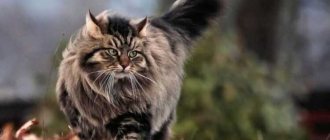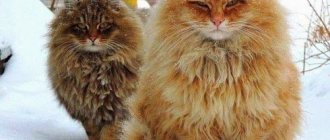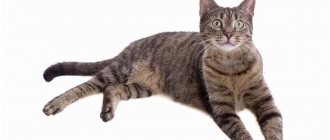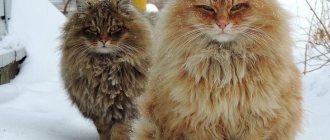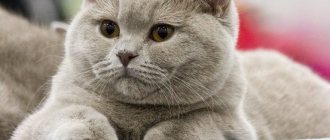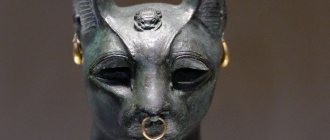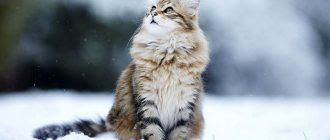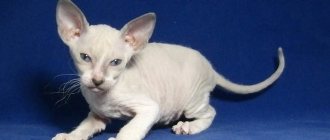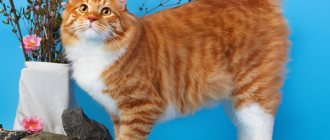The huge Siberian cat, adapted to the harsh climate, lives on the vast territory of the Siberian region of Russia. These owners of the Taiga, together with other animals, adapted to difficult living conditions, learned to get food, catch birds and small animals.
Living with humans, they exhibit hunting instincts and have become assistants in getting rid of rodents. Siberian cats have received recognition as the best rat catchers. These long-haired beauties are smart, have a balanced character and get along well with all family members.
Origin story
Despite its name, the grandmothers of the Siberian cat are considered to be people from Asia. Traveling with traders, Bukhara cats reached Siberia and, together with merchants, began to develop vast territories.
Local residents willingly bought animals for their dexterity and dexterity in fighting rodents. Gradually, Bukhara cats became close to representatives of local wild breeds, and their kittens acquired fluffy and warm skin and excellent hunting skills.
It is believed that the first representatives of this breed appeared in the east of the Urals and gradually spread throughout the cold region. The first mention of these animals was recorded in written sources of the 16th century.
In any photo, a Siberian cat shows all the charm of the fluffy breed.
External characteristics
According to the World Federation, the description of the Siberian cat breed is as follows:
- weight from 6 kg (some males can reach 10-12 kg);
- height 30-40 cm at the withers, proportional to weight;
- various colors;
- life expectancy up to 20 years;
- notes of independence in character;
- a combination of attachment to the owner with suspicion of strangers;
- high degree of protective instinct;
- ability to remember and learn.
Siberians are classified as breeds with semi-long hair.
Unlike other felines with similar characteristics, they are hypoallergenic.
Character of the Siberian cat
Smart and quick-witted representatives of this breed, like true Siberians, are friendly and sociable. Although they can show their character on the other side - pride and independence also correspond to the description of this breed.
For recommendations on caring for cats at home, see the portal about animals https://zhivotnyeplanety.ru/.
Cats become very attached to people, although they do not like strangers, especially if they pick the cat up without permission. And they won’t allow their owners to squeeze them too much.
They treat children well, but will not allow them to hurt themselves.
Siberians are not a picky breed at all. They will play with whatever their owners offer them or get a toy on their own. This could be an ordinary candy wrapper, a piece of paper or rope.
A well-developed hunting instinct allows them to protect homes from rodents. There are known cases when such hunters, left without prey, caught ferrets and rabbits.
Siberian cats have well-developed jumping ability, so if the owners do not see the cat on the floor, they should inspect all the cabinets - the hunter can monitor the situation from above.
The Siberian breed can be used as watchdogs - they will selflessly defend their territory and are wary of strangers.
They are not afraid of dogs and can start a fight with them if they think that they have violated territorial boundaries. They are also not afraid of sharp sounds.
Siberians are considered calm and balanced animals, although the Siberian cat kitten loves to play and be naughty. Some cats retain their lively character even into adulthood.
The roots of wild cats will not allow her to adapt to a person; she will still remain in her opinion and will not follow people, asking for attention and affection.
But they will not leave the owner if he is sick or upset. To become a real owner for such a cat, you must respect the requirements and dignity of the animal.
Ultrasound of animals. Why is it made?- Where can I take veterinary courses and what are they for?
Akita Inu. What kind of breed is this and what are its characteristics?
Survival in the harsh conditions of Siberia has developed prudence and intelligence in these cats. She will think first and then act.
The Siberian breed is excellent for private homes, where it is given opportunities for hunting and walking. A cat living in the city should be taken for walks regularly.
It is advisable to wear a harness so that the animal does not run away, driven by hunting instincts.
A pet of this breed must have its own place - a house or a bed - where no one will touch it. A multi-tiered cat house is well suited for this purpose, in which the animal can play and sleep.
Elementary rules of genetics
1. Two long-haired parents cannot produce a short-haired kitten. Only the parents' colors determine the color of the kitten. The colors of other cats present in the pedigree do not have a direct effect on the color of the kitten. 2. A cat kitten always gets its color from its mother. 3. A female cat always receives a color that is a combination of the colors of the father and mother. 4. To obtain a genetically red or genetically cream cat kitten in the litter, it is necessary that the father be genetically red or genetically cream, and the mother must also have red or cream colors in the genotype 5. Dominant characteristics (dominant colors: white, silver, tabby, bicolor, etc.) cannot skip a generation. They cannot pass, for example, from grandfather to grandson, without manifesting themselves in the father. 6. A kitten of a dominant color (black, red, tortoiseshell, etc.) must have a parent of a dominant color. 7. Two parents of a recessive color (cream, blue, etc.) cannot produce a kitten of a dominant color (black, red, tortoiseshell, etc.) 8. A white kitten must have a white parent. 9. A kitten with a white undercoat (veiled, shaded, smoky) must have a parent with a white undercoat. 10. A veiled/shaded kitten must have at least one parent who is either a veiled/shaded or a tabby. 11. A veiled/shaded parent can produce a smoky kitten, but a smoky parent cannot produce a veiled/shaded kitten. 12. A tabby kitten must have at least one parent who is either veiled/shaded or tabby. 13. All red cats have some degree of tabby. The ability to produce tabby offspring depends on whether the red cat (or cat) is a true tabby, i.e. does she have a tabby or veiled/shaded parent, or is she just a red cat with a pronounced tabby pattern. A red tabby, unless it is a true tabby, cannot produce a tabby offspring of any other color unless it is bred to a true tabby (or a veiled/shaded one). 14. A brindle tabby kitten must have a brindle tabby parent. 15. A spotted tabby kitten must have a spotted tabby parent. 16. Multi-colored specimens (tortoiseshell, blue-cream, calico, tortoiseshell and white, tortie-point, etc.) are almost always female, but males are sometimes born. 17. A bicolor kitten must have a bicolor parent. 18. Two color-point parents cannot produce a non-color-point kitten (see point 8). 19. It is possible to get a Himalayan kitten only if both parents are carriers of the Himalayan color (even if they themselves are solid color). 20. If one parent is of the Himalayan color, and the other is not and is not even a carrier of the Himalayan color, then not a single kitten of the Himalayan color can be in the offspring.
(CFA Breeder's Guide “Basic Principals of Cat Genetics”) Source – www.rolandus.org
POSSIBLE COLOR OF SIBERIAN KITTENS IN THE LITTLE
Description of the Siberian cat breed
The animals have a strong, muscular body and have magnificent thick fur that protects its owner during frosts.
With the onset of cold weather, the fur coat becomes even warmer, and winter pants and a collar appear. Due to its special properties, the animal’s fur does not get wet very well.
The colors of the Siberian cat can be very diverse. White and black, silver and blue, brindle and tortoiseshell, two- or three-color colors are acceptable here.
Colors
These pets have about two hundred color options, but not all of them correspond to the standard. They can be divided into the following groups:
- tortoiseshells,
- smoky,
- plain,
- colorpoint,
- two-color,
- tabby
Kittens are born with blue eyes, which change over time according to genetics. Solid colors of Siberians are characterized by a uniform coat tone and the absence of spots. The furs are dyed along the entire length. The eyes are amber or copper, but can also be blue. In this group, the most popular colors are blue, white, black and red. Tortoiseshells are a combination of three colors, while tabbies are striped.
The smoky color looks great, and chinchillas also belong to it. Smoky fur shimmers in the sun, and these cats have light eyes. Chinchillas are more reminiscent of silver, their fur is very delicate, they seem to be shrouded in fog.
The colorpoint color includes light and dark colors, the body is light, but the paws, tail and muzzle are darker. The most popular in this group are Neva masquerade individuals. They have cream-colored fur and darkened limbs and ears. There is a mask on the face. Two-colored animals always have white spots. The delicate shade should occupy approximately one third of the entire body, and the boundaries should be clear.
brindle
In other words, it's a tabby. These animals resemble real tigers, but they do not have to be red.
There is, for example, a very original black brindle color. Breeders pay a lot of attention to the correct placement of stripes. At the same time, the letter “M” is clearly visible on the cat’s forehead, stripes on the back and sides, continuous ringing “necklaces” on the neck, stripes stretch from the back to the stomach. Two rows of dots of the main color are visible on the abdomen.
To read: DIY enclosure with a booth for a German shepherd
These kisuls have very bright eyes, most often light yellow or light green, they are emphasized by rimming and look very expressive. Their tail is also very cute, reminiscent of a raccoon. The base color can be anything, but most often it is light brown. This skin helped the wild ancestors of these beauties to camouflage themselves in forests, steppes and among tall autumn grass.
Tortoiseshell
It consists of a combination of solid colors, when large spots are located on the body. As a rule, it occurs only in females.
They look very bright, variegated, but at the same time they are difficult to notice if they are hiding somewhere in the foliage or in the sedge.
They are good at camouflage. Tortoiseshell coats look very original, areas of different colors form a beautiful combination, while a cream or red tone is always present. These individuals have amber, copper or red eyes.
Gold (Red)
The undercoat of such pets is usually apricot, with charcoal tassels on the ears, the same end of the tail and paw pads. They can also be dark brown. A golden cat can only come with a pattern; there is no smoky variety. The cornea is most often green or green-blue. This is a very rare and therefore valuable color. There are also silvery individuals, and they have white hair roots.
Black smoke
Smoky colors, in principle, differ in that they cannot be identified when the animal is stationary, but when moving, it is clear that the coat is white at the base and darker at the top. In addition to black smoke, there is also blue and red smoke.
The undercoat of the charcoal smoky beauties is completely white, but at the tips the hair is black, the contrast is very visible. Disadvantages include uneven color on different parts of the body and a residual pattern.
Photo of a Siberian cat
Read here Laperm: description of the breed, keeping a purebred cat and features of its choice (130 photos)
Help the site, share with friends 
Advantages and disadvantages
Like any other cat breed, the Siberian cat has its own characteristic features.
Advantages of the breed:
- playful, affectionate, gentle;
- gets along well with children;
- unpretentious;
- quickly gets accustomed to the toilet and scratching post.
Disadvantages of the breed:
- may be willful;
- restless;
- suffers from mood swings and does not always respond in kind to the owner’s affection;
- Requires daily brushing during shedding.
There is a version that the Siberian breed is hypoallergenic. However, there are no completely hypoallergenic cats. People with allergies, to make sure whether a Siberian will cause a reaction, can spend several hours in his company and finally decide whether to get this breed.
How to choose a kitten
For a purebred pet, you should go to a nursery or an exhibition. They buy a Siberian kitten who is 3 months old. At this age, he is already independent, vaccinated, accustomed to the tray and scratching post. The seller is obliged to provide the buyer with a veterinary passport with vaccination marks and documents confirming the pedigree.
Healthy Siberian kittens:
- well-groomed, well-fed;
- active, inquisitive, not fearful, not aggressive;
- with smooth, shiny coat without bald spots or signs of parasitic infestation;
- with clean eyes, ears, nose, anus.
A pet-level Siberian kitten (companion) can be bought for 8–10 thousand rubles. A pet of the breed category (for breeding) will cost 15–20 thousand. And for a show category kitten you will have to pay 30-35 thousand rubles.
Original nicknames
An elite Siberian cat should not be called by a simple name; either a majestic and worthy old name is selected for it, or an original nickname that reflects its appearance and character traits:
- since the breed is Russian, then old Russian names are suitable - the cat Lyubava, Ulyana, Marfa, Varvara, Melanya, the cat Methodius, Nestor, Simon, Khariton, Miron, Elisha, Savely;
- aristocratic foreign names - cat Gloria, Isabella, Penelope, Jeanette, Charlotte, cat Archibald, Reinhard, Salvador, Oliver, Edgar;
- nicknames reflecting character - cat Vredina, Weasel, Bestia, Sissy, Quiet, Madonna, Princess, Sonya, Lighter, cat - Pirate, Master, Ataman, Grumpy, Mattress, Fat Man, Sparky, Demon; names reflecting color - cat Tuchka, Snezhana, Klyaksa, Cinnamon, Alba, cat Gray, Snow, Knight, Rufus, White, Black;
- according to the owner’s favorite delicacies - cat Toffee, Cookie, Bounty, Candy, cat Zephyr, Pate, Baguette, Lemon, Apricot, Donut, Biscuit, Raisin, Truffle;
- popular - Astra cat, Akira, Leia, Selena, Erica, Felix cat, Cody, Simba, Murphy, Kevin, Lucky;
- funny ones - the cat Button, Firecracker, Tablet, the cat Mityai, Boniface, Twix, Hippopotamus, Macho, Gypsy.
Owner reviews
The owners of Siberian cats are confident that it is impossible to find a more spectacular, phlegmatic and self-confident pet. Siberians have a stable psyche, are not prone to outbursts of aggression and most often become an integral part of the family.
What especially attracts owners is the excellent health of Siberians, the absence of hereditary diseases, the main thing is not to overfeed the pet in order to protect it from obesity, as well as a minimal range of care procedures. The most “troublesome” thing, according to the owners, is caring for a luxurious fur coat, but it doesn’t take much time.
